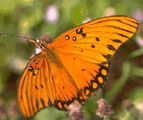Native Plants
Search for native plants by scientific name, common name or family. If you are not sure what you are looking for, try the Combination Search or our Recommended Species lists.
Passiflora tenuiloba
Passiflora tenuiloba Engelm.
Birdwing Passionflower, Slender-lobe Passionflower, Spread Lobe Passionflower, Bird Wing Passionflower
Passifloraceae (Passion-Flower Family)
Synonym(s):
USDA Symbol: PATE9
USDA Native Status: L48 (N)
A vine with tendrils in leaf axils and bizarre, greenish flowers.
Unlike this species, which has evolutionarily lost its petals, most Passiflora have 10 petal-like parts; the common name passionflower relates to the resemblance of these flower parts to aspects of the Crucifixion story. The 10 petal-like parts represent the disciples, excluding Peter and Judas; the five stamens, the wounds Jesus received; the knob-like stigmas, the nails; and the fringed corona, the crown of thorns. There are several Passiflora species in the Southwest.
Plant Characteristics
Duration: PerennialHabit: Vine
Leaf Retention: Deciduous
Fruit Type: Berry
Size Notes: Stems scrambling over ground, rocks and other plants, up to about 4 feet long.
Fruit: Dark blue to black.
Bloom Information
Bloom Color: Green , PurpleBloom Time: Apr , May , Jun , Jul , Aug , Sep , Oct , Nov , Dec
Distribution
USA: NM , TXNative Distribution: Southern New Mexico, southwestern Texas, and northern Mexico.
Native Habitat: Open limestone areas, dry, caliche soils, growing over boulders and sometimes into low shrubs; mainly in Edwards Plateau to south Texas.
Growing Conditions
Water Use: LowLight Requirement: Part Shade
Soil Moisture: Dry
Conditions Comments: As are other species of Passionvine, Slender lobed passionvine spreads by suckering and is a larval food plant for Gulf fritillary, Zebra longwing, and Julia butterflies. The flowers are not large or brightly colored, but are very intricate and delicate.
Benefit
Conspicuous Flowers: yesInteresting Foliage: yes
Attracts: Butterflies
Larval Host: Gulf Fritillary
Deer Resistant: Minimal
Butterflies and Moths of North America (BAMONA)
|
Gulf Fritillary (Agraulis vanillae)  Larval Host |
From the National Organizations Directory
According to the species list provided by Affiliate Organizations, this plant is on display at the following locations:Lady Bird Johnson Wildflower Center - Austin, TX
NPSOT - Austin Chapter - Austin, TX
National Butterfly Center - Mission, TX
Herbarium Specimen(s)
NPSOT 0437 Collected Jun 24, 1993 in Comal County by Mary Beth WhiteNPSOT 0687 Collected Sep 20, 1993 in Bexar County by Mike Fox
Wildflower Center Seed Bank
LBJWC-1204 Collected 2008-08-18 in Brewster County by Lady Bird Johnson Wildflower CenterBibliography
Bibref 1186 - Field Guide to Moths of Eastern North America (2005) Covell, C.V., Jr.Bibref 1185 - Field Guide to Western Butterflies (Peterson Field Guides) (1999) Opler, P.A. and A.B. Wright
Bibref 286 - Wildflowers of the Texas Hill Country (1989) Enquist, M.
Search More Titles in Bibliography
Web Reference
Webref 38 - Flora of North America (2019) Missouri Botanical Garden, St. Louis, MO & Harvard University Herbaria, Cambridge, MA.Webref 23 - Southwest Environmental Information Network (2009) SEINet - Arizona Chapter
Additional resources
USDA: Find Passiflora tenuiloba in USDA PlantsFNA: Find Passiflora tenuiloba in the Flora of North America (if available)
Google: Search Google for Passiflora tenuiloba
Metadata
Record Modified: 2023-02-21Research By: DIEHL